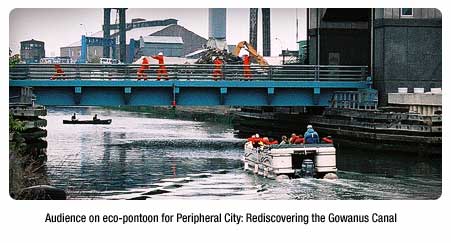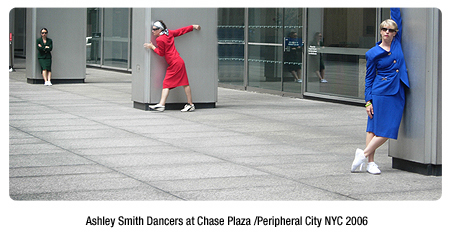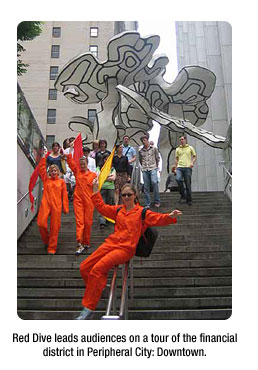Who we are
Red Dive was founded in 1996 by group of women working independently in theater and dance who sought to radically re-envision how and where performance is presented. They aimed to advance cross-disciplinary collaborations within a theatrical context and create a model of collective arts management. Inspired by happenings, public art and street theater experiments of earlier decades, their mission quickly evolved. Today, Red Dive is a New York vanguard in what is best described as site-specific, performance tours. They have transformed a school building, tenement building, Brooklyn’s Gowanus canal and many of New York’s lesser-known streets, neighborhoods, and public plazas into hosts of performance. Using performers as guides, Red Dive has led close to two-thousand audience members through sites animated by a crafted series of wide-ranging artistic works. Red Dive performance-tours have explored such themes as immigration, urban environmental renewal, post 9/11 re-developments and more. Appropriately, Red Dive was the first group to receive a BESSIE in the category of ‘new media and performance installation’ and they continue to garner attention with prestigious commissions, grants and critical acclaim.

Current News
In October 2006 Red Dive successfully completed their most prominent project, a 3-year program, Peripheral City (see Programs & Events History). Maureen Brennan (now Maureen Huskey), Red Dive Co-founder and Artistic Director 2001-2006 and Ellen Baird, Co-founder, Peripheral City Project Director and current Archival Manager, are available to represent Red Dive on panels, symposiums and academic related events. Contact us
Unfortunately, public performances and events are discontinued indefinitely at this time.
How we work
Red Dive breaks the mold of traditional hierarchical structures in the performing arts community in which one person such as the choreographer or playwright drives the content of a work or a founder or executive director determines the vision of a company. Since 1996 Red Dive has explored a collective-driven management model and has pursued an aesthetic vision that democratically integrates wide-ranging artistic voices into a single performance experience.
Red Dive collectively devises projects that focus on under-explored places and marginalized subjects and each project begins with a multi-faceted collaboration involving anywhere from a few to over 20 independent artists, companies and performers. The criterion for selecting artists changes with each project and may include peer recommendations, personal invitation, or a call for proposals. The only fixed criterions for choosing artists are a passion for collaboration, the exploration of new forms and a willingness to push one’s own individual vision towards a larger aesthetic goal.
Who we work with
To date, Red Dive performance-tours have merged the unique work of close to 300 artists and performers including that of playwrights, choreographers, architects, puppeteers, sound and video artists, disc jockeys, comedians, conceptual artists, actors and others, into a single, collective vision. Artist demographics have represented a wide range in cultural backgrounds, age (i.e. 19 – 77 years), and experience levels including professional, award-winning artists and artists just starting out. Red Dive is also committed to creating projects that engage non-art entities such as local businesses and community groups. For example, a father and son-owned barbershop became a focal point in the Peripheral City tour in lower Manhattan and an environmental group, the Hackensack Riverkeeper, was the host of Peripheral City: Rediscovering the Gowanus Canal (see Programs & Events History). Through Red Dive’s facilitation and ensemble-style direction, multi-view points converge to yield a complex interpretation of social issues and provide a greater impact on the audience experience.
The Site Specific, Performance-Tour
Red Dive founders started out creating work for New York’s typical "downtown" venues like the performance hall and black box theater and wanted to create a format that would challenge the passive audience-performer relationship inherent in these settings. They wanted an artistic experience in which audiences could engage with many different kinds of art and performance on a multi-sensory level and interact with each other and the surroundings in a heightened way.
Red Dive’s performance-tour format, designed for intimate audience sizes of 6 – 20, requires audiences to physically travel through an environment and experience every-day occurrences and the city environment within a performance context. During Red Dive tours artistic encounters such dance under a bridge or a sudden street corner monologue from an apparent pedestrian, come at unexpected moments and blur the distinctions between real life and art. In addition, the Red Dive multi-disciplinary tour brings current issues, history, art, and family-style entertainment into a single experience and, in some cases, inspires civic engagement. Immediately following Red Dive’s Peripheral City: Rediscovering the Gowanus Canal, a number of audience members joined a grass roots canoe club (The Dredgers) dedicated to keeping the canal clean and others made financial contributions to the Riverkeeper, a non-profit environmental organization that hosted the Red Dive canal tours.
Crafting the experience
For Red Dive, working in the site-specific realm means drawing content material from the site itself: its histories, conflicts and the many varied human investments. Even the mundane or seemingly indistinct aspects of an area are researched and reinterpreted to offer a deeper perspective and civic engagement.

The artistic or project director maps the tour’s physical route and identifies the various viewing points and stages for theatrical interactions, performances and installations--such as a video displayed in a storefront window. Once a route is determined, Red Dive, working with the participating artists, devises a storyboard-like "text" for the tour. Inspired by on-the-street interviews*, history, and imagined futures of the area, the text helps the participating artists link their project to a larger narrative, and helps the artistic director determine the sequence and placing of the tour’s artistic episodes.
From beginning to end--whether inhabiting ten city blocks or a confined indoor environment--Red Dive employs techniques of dance choreography and theater skills in order to bring the performance-tour/event together. Dynamics of rhythm, energy, and composition are structured for specific dramatic ends and emphasis is put on making the audience a visceral part of the performance. The artistic director often works with a dramaturge to help cultivate a dramatic arch within the challenging context of multi-disciplinary communication and to ultimately manifest a story within this non-linear form. Red Dive is interested in alternative narratives and evolving a new kind of theater.
*Often the actual recordings or spoken text from these interviews become a part of the tour’s narrative.
 Use of Guides and Live Music Use of Guides and Live Music
A distinctive crafting and aesthetic element to Red Dive’s performance tours is the integrated use of guides and live music. Red Dive developed the "performer guide" in 1997 with their interactive tours of the Lower East Side Tenement museum and have used them ever since. In One Less Sense (2000), a blindfolded audience placed total trust in guides who, through the sensation of touch and whispers, led audience members individually through a multi-sensory, interactive environment inside an old school building. With every project the performer guide represent a character or persona--fictional or non-fictional--that speaks, uses silent gestures, or maintains a quiet visual presence to provide a sense of seamlessness throughout a tour.
Musicians serve many roles for Red Dive tours as well. Sometimes they become the guides as they walk and play instruments alongside the tour or they appear in the periphery animating an overlooked piece of architecture through rhythm and sound. For Peripheral City: City of Refuge in New York’s Chinatown, the musicians created the overall dramatic tone and emotional layering for the tour’s story. Red Dive’s use of guides and musicians serve to create a context for the randomness inherent in site-specific work, and they bring the often-disparate artistic expressions, real-life encounters and separate narratives into a unified, cohesive meaning.
The Production Side
Red Dive produces their own work with a methodology developed specifically for multi-site management and orchestrating back-to-back performance tours ranging from 3 to up to 8 tours in one day/evening. This requires meticulous planning, timing and safety measures. Participating artists and performers are required to craft their work to adapt to these formats. Consequently, artists have claimed that the demands of the format forced them into fresh territory and ideas about performance.
Red Dive’s methodology for producing tours and events includes a protocol for working with neighborhoods, partnering organizations and public agencies in order to garner support, access permits and build overall community relations. Informal and formal networking ranging from on-the-street conversations to town meetings, as well as working with city council members and attending local taskforces, have become standard procedure.
Extensive site research and pre-production involvement with communities has allowed Red Dive to forge uncommon bridges between art and non-art entities. For example, after negotiations with a Brooklyn police department over public sound permits, Red Dive surprisingly became the precinct’s first-ever sponsored artist group and were invited to represent the precinct at community engagements. This opportunity gave Red Dive a unique access to new audiences and the chance to bring "avant-garde" art and performance to generally conservative settings.
Red Dive projects maintain a low-tech aesthetic and aim to frame the natural conditions of a physical landscape and put the human experience—that of both the audience and performer—in the center of the artistic experience.
Copyright Maureen Huskey (formerly Brennan) —Red Dive Co-founder and Artistic Director 2001-2006 For use or reprint of any part of the above text, please contact maureenhuskey@gmail.com. Thank you.
Red Dive Associates and Partnering Organizations
Red Dive has worked with The Lower East Side Tenement Museum, The Foundry Theater, Dancing in the Streets, Inc., The Clemente Soto Velez Cultural Center, The US Army Corps of Engineers, New York University’s Gallatin School of Individualized Study, The Gowanus Canal Community Development Corporation, The Brooklyn Arts Exchange, The Brooklyn Historical Society, The Dredgers, The Urban Divers, The Gowanus Wildcats, The Working Waterfront Association, The Hackensack Riverkeeper, Inc., The Department of Transportation, Brooklyn’s Community Board 6, Brooklyn’s 76th Police Precinct, The Museum of Chinese in the Americas, (MOCA), Explore Chinatown, Yellow Arrow, The Lower Manhattan Cultural Council (LMCC), Sound Associates Inc., The Brooklyn Brewery, and members of the small-business community including the Blind Tiger Ale House and d.b.a in New York’s east village.
Funders
Red Dive’s past funders and supporters include The Field through the Joyce Mertz-Gilmore Foundation, Creative Capital, The Greenwall Foundation, Heathcote Foundation, The Foundry Theater’s Emerging Artist’s Fund through the Jerome Foundation, The Puffin Foundation, The Curtis McGraw Foundation, New York State Council on the Arts administered through the Brooklyn Arts Council, Franklin Furnace Foundation, Meet The Composer Foundation, Lower Manhattan Cultural Council and private donations.
|